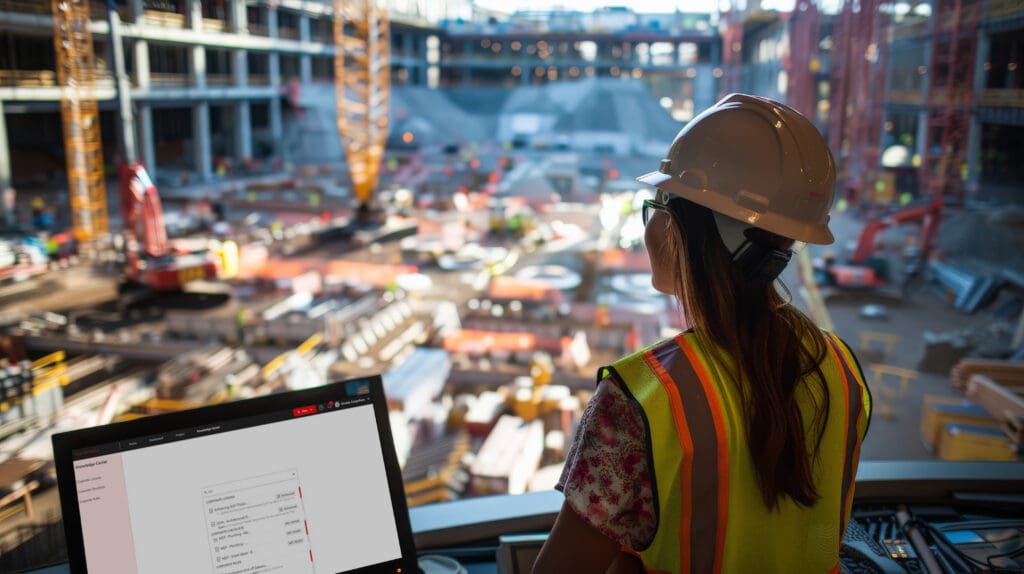
Navigating the AI Revolution in Construction: Two Steps Every Owner Can Take to Be Ready
By Danielle Dy Buncio, Founder and CEO at VIATechnik
Newsflash: You don’t have two years to figure out AI.
If you think there’s still time to be a wait-and-see observer of AI, your business is at risk.
Think about Sears. The once-booming retailer founded in the 1800s waited to create a robust online shopping experience in the name of tradition. “What will people do without our catalogs?” But they went too long without excellent digital experiences, and they could never (and didn’t ever) catch up with Amazon. They were too late. There was a tipping point, and they missed the boat. They filed for bankruptcy in 2018.
In the construction industry, it’s tempting for owners to wait for the current AI frenzy to play out and then adopt the proven tools that rise to the top. But technology is accelerating so quickly that being a “fast follower” is no longer a viable strategy. By the time you decide to catch up, you’re likely too late to regain a meaningful competitive advantage.
Said differently, the construction industry no longer has the luxury of being reactive.
Business owners who take a proactive approach to AI today will be successful — both in the short-term and in the long run — as they outcompete their peers who are waiting on the sidelines.
Let’s dig into what AI in the construction industry looks like now, what adopting it moving forward should look like, and how VIATechnik is meeting owners in their moment of need.

The Impact of AI in Construction
Today’s property owners and construction professionals have good reason to care about AI’s advantages; it promises massive productivity gains.
Going over budget and over the original timeline is almost a norm in this space. But I’ve already seen for myself how the status quo can become a thing of the past with thoughtful AI incorporation.
As the founder of a firm that specializes in construction technology consulting, I know AI is a valuable tool that’s helping today’s owners learn from what happened in the past and unearth insights that enable better decisions, both in the future and today.
How AI Can Be Applied Today
The power to make informed decisions has a domino effect; it allows your projects to move faster and cost less while increasing safety and quality.
As Andrew Volz, a research lead at JLL, says, “AI technology has the potential to shift how we work in construction. These tools heighten accuracy and give time back [to owners] by changing the need for project managers, specialists, and inspectors to be frequently on site.”
How exactly does this work? It all starts with data.
To feed AI capabilities, you must first create robust data repositories to house your project data. Then, you layer AI on top of that data library to identify trends and actionable insights.
That can feel intimidating, especially if you’re just getting started with AI. (If you want specific attention and support, our team would be glad to help.) But it’s not too late! If you’re looking for a way to take a step forward with AI today and avoid falling behind, I recommend focusing on two specific paths:
- Explore AI
- Strategize with AI
The Two AI Paths Construction Owners Should Be Taking
When I talk to our clients about the emerging role of AI, I encourage them to start with two concurrent paths: exploration and strategy.
Let’s dig into both of them and speak practically about what it looks like to get started with AI in construction.
1. Explore: Try out Commercially Available Tools
You can’t imagine possible use cases and solutions if you don’t just start playing around with them and adding them to your life at work, or even at home.
Try playing around with the modern buffet of AI technology by taking advantage of commercially available tools like OpenAI’s ChatGPT, Google’s Gemini, Anthropic’s Claude, and Midjourney.
From there, you’ll start to understand the range of possibilities for how your organization could benefit from these amazing tools.
Curious about how this could impact organizations like yours? Here are just a few examples of outcomes that are particularly relevant within the world of construction:
A. Better Data Analysis
The primary benefit of AI is its ability to analyze and gain insights from large amounts of data, at volumes and speeds that simply aren’t possible for humans.
For example: We recently worked with a construction client and pulled in data from over 100 of their past projects. The data extraction process turned up over 300,000 historical construction issues.
Next, the generative AI built into our Precogs platform showed that of those issues, there were over 900 common themes, ranging from weather delays to material selection issues. The AI also generated over 1,300 “lessons learned.”
Ultimately, human subject matter experts reviewed the AI findings and distilled the lessons learned down to approximately 500 that will guide this client’s future work. Adding human expertise to verify the findings is important, to confirm that you are capturing the right leverage points and thinking outside the (AI) box.
B. Real-Time Decision Making
Top owners take those data-based insights and put them to use in real-time to drive better project planning and execution.
For example, imagine one of your under-construction buildings is ready for drywall, but the drywall contractor doesn’t show up. Curveballs like this happen all the time, no matter how well you’ve planned.
The key here is being able to make the next best decision, faster. Should you hire another contractor in your network or patiently wait for your first choice? AI platforms like Precogs can help you determine what you can do to limit the impact of the delay, using data as the guide.

C. Simplified Process Optimization
Turning construction problems into construction knowledge is one of the things AI does best — and this ability impacts multiple phases of the building lifecycle, from the planning process to the design, construction, and operations.
For example, imagine you are building a second data center in California, and you want to use the same contractors but achieve better outcomes. AI can surface learnings from the first engagement to optimize the next.
Similarly, if a designer working in a Building Information Model (BIM) of the new data center elects to use a specific material, an integrated AI solution could comb the metadata of the current project, compare it to the “lessons learned” from past projects, and push out relevant knowledge directly to the designer.
By scaling knowledge across an organization, you gain exponential potential across the board.
These are just three of dozens of benefits of AI exploration in the early stages. It can be for you, it can be for your team, and it can be for your business. This early exploration is an opportunity to use your imagination and come up with solutions that’ll prevent you from becoming the next Sears.
But in order to fully capture the benefits of AI, exploration is not enough. You also need to develop a coherent strategy for how these tools can accelerate your key business outcomes.
2. Strategize: Create an AI Strategy to Improve Your Business
As you try out different tools, it’s also time to start thinking about what problems you want to solve, and what innovation and data your firm needs to thrive in the coming 5-10 years.
This will likely require:
- Integrating data from multiple sources
- Layering on AI to gain new insights
More tactically, here’s what getting started with an AI strategy looks like at VIATechnik.
Clients walk through a progressive five-step AI roadmap that begins with identifying problems and opportunities and ends with implementing automation:
- Problem & Opportunity Identification
- Digitization
- Integration
- Insights
- Automation
To build a successful foundation in AI today, you need to focus on the first two steps above all else. When I speak with clients about problems and opportunities, I’m not focused on granular problem/solution scenarios.
When you play whack-a-mole with individual problems, it’s easy to come up with band-aid solutions instead of a long-term strategy.
Instead, I ask them questions like:
- What do you want your business to look like in 10 years?
- What is important to the enterprise?
- What does it look like today that it shouldn’t look like tomorrow?
- Where can AI help you and your core business?
- What can AI teach you about your construction process?
Thinking through these questions properly will save you an incredible amount of time and money.
When it comes to step two, digitization, it’s all about surfacing the contextual data that will help you identify opportunities to improve your business. For example, if you notice you’re spending 40% more than your initial construction budget, it may be because you’re making changes late in design or during construction that result in higher fees. To use data to solve this problem, you would need to:
- Collect and digitize your historical budgets
- Collect and digitize your historical change orders
- Invest in digitized workflows for the future
By digitizing this information, you equip your organization to take the next steps on the AI roadmap: integrating your datasets, pulling out existing insights, and developing automations that serve you in the future.

Artificial Intelligence, Real Results
Today’s AI craze may appear like a temporary evolution. But as someone who’s in the digital trenches with construction owners, I believe we’re on the cusp of a transformative revolution.
Making better, faster decisions, especially when those decisions rely on large amounts of data, is infinitely easier with AI. By combining the volume of information that AI can process with human ingenuity and adaptability, owners can move from data insights to action.
Today’s construction leaders need to be able to adapt quickly and react to changing circumstances. Data supercharged by AI is one obvious way to do so—and I think the AEC industry is catching on.
Navigating this revolution isn’t easy, but it’s absolutely necessary.
And if you get stuck, that’s okay — we’re here to help.



